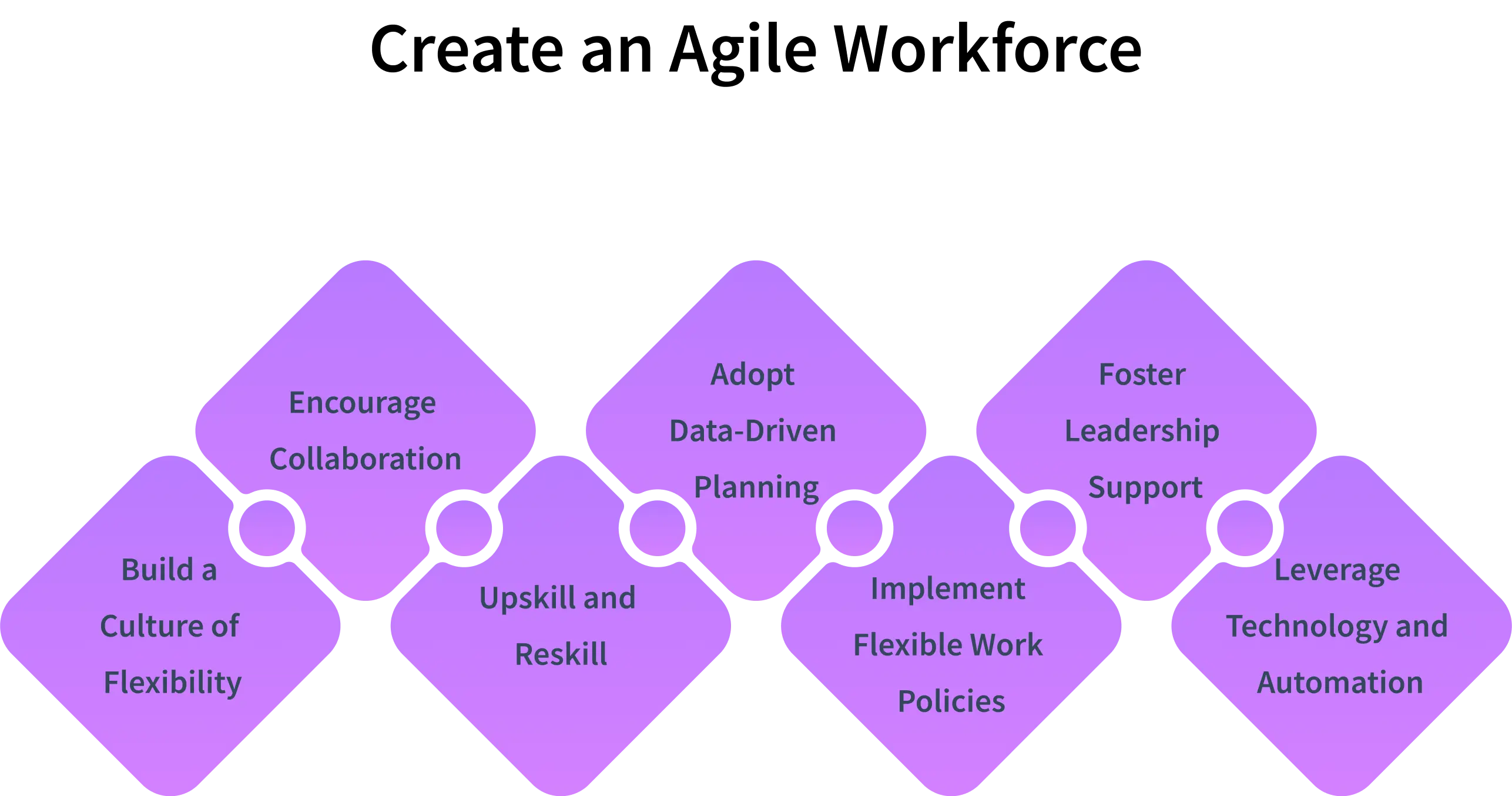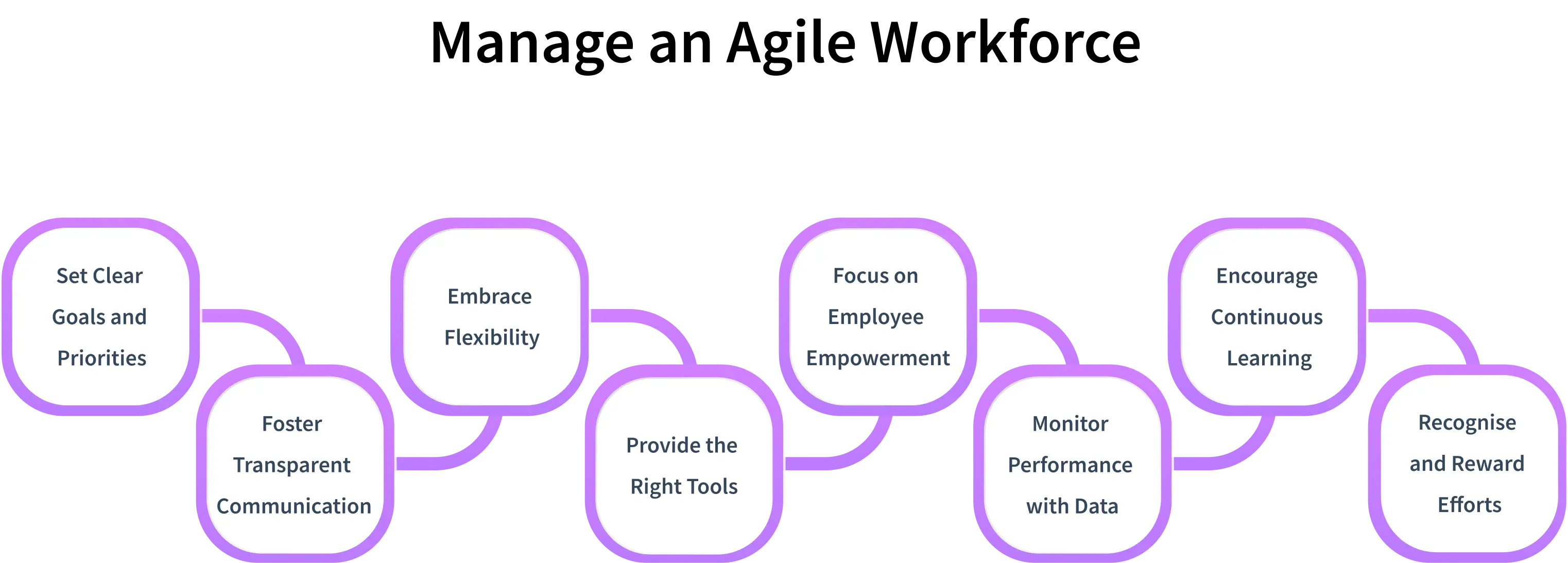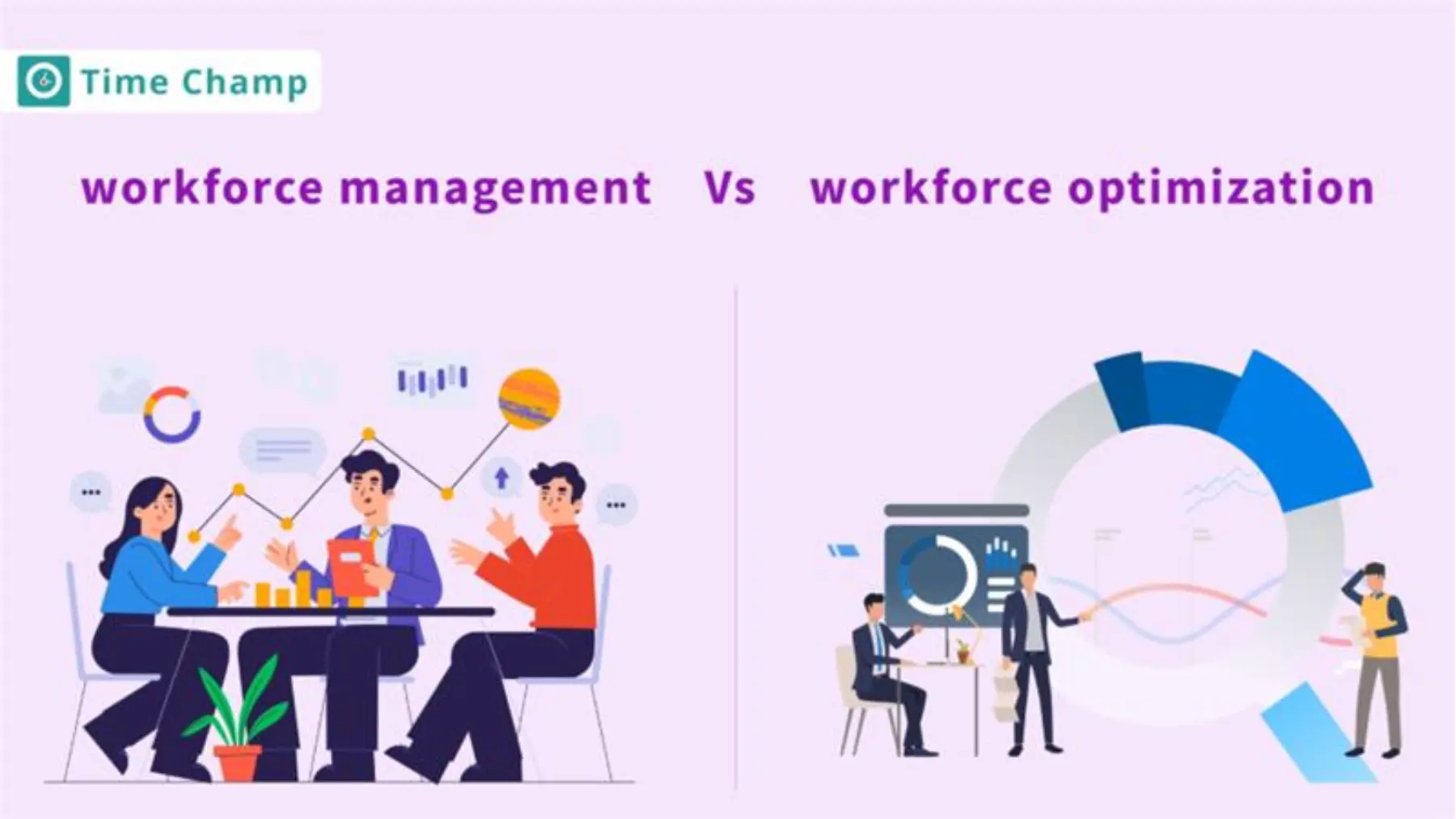You never know when you might suddenly need an extra employee for that emergency shift, and that’s exactly why many businesses are turning to agile workforce management.
In fact, AgileSherpas State of Agile Marketing Report custom reveals that 86% of marketers say they plan to move part or all of their marketing teams to agile ways of working.
In this blog, you are going to learn about what an agile workforce means and how to create one, along with a few benefits and challenges, of course.
What Does an Agile Workforce Mean?
An agile workforce refers to a team or group of employees who can quickly adapt to different changes in work demands, schedules, and business priorities. These workforces operate in a flexible and collaborative way that is ready to take on new tasks as situations change.
The only aim of an agile workforce is to help your organisation respond faster to challenges, improve productivity, and stay competitive in the market. This often involves using technology at its best, learning continuously, and ensuring cross-functional teamwork so employees can move between projects, support urgent needs, and deliver results without any delay.
Why is an Agile Workforce Important in Modern Businesses?
Just think, you don’t have someone to take up on an important task and complete it on time, when it’s a work emergency, pressuring, right? Agile workforces lend a hand in peak work hours and emergencies. Here are more reasons why they are so important:
1. Quick Response to Emergencies
Agile employees come up with solutions just in time when you have urgent tasks to deal with and avoid work delays. This keeps your business operations smooth even under pressure.
2. Better Use of Talent
Agile teams can easily shift roles and responsibilities depending on priorities. This ensures the right people are working on the right tasks at the right time.
3. Improves Collaboration
When your team operates in an agile way, cross-functional teamwork becomes much easier. Departments, as well, can work more collaboratively to solve problems faster and keep the projects on track.
4. Higher Productivity
Being flexible will help your employees concentrate better on the most important tasks and reduce downtime. This helps you ensure that your business meets deadlines with zero stress.
5. Staying Competitive
Agility helps your business to always keep up with the changing trends, and companies that adapt quickly are better prepared to grab new opportunities and handle challenges.
How to Create an Agile Workforce?

Building an agile team involves creating a culture, processes, systems, and most importantly, schedules that allow your teams to adapt quickly without compromising on productivity. Here’s how you can do it:
1. Build a Culture of Flexibility
First, you need to create a flexible culture for your teams, because agility always begins with the right mindset. Make sure your employees feel empowered to adapt to new priorities without any feeling of overwhelm. In fact, a Gallup research indicates that employees working in agile environments report engagement levels about 23% higher than in traditional work setups. To build such a culture, start encouraging open communication, experimenting, and everyday problem-solving.
2. Encourage Cross-Functional Collaboration
When teams from different departments collaborate with each other (e.g., sales, engineering, operations), it results in improved outcomes. For example, McKinsey documented a case where cross-functional teams improved first-time correct delivery from approximately 65% up to over 80%, and reduced customer help requests post-installation by about one-third.
3. Upskill and Reskill Continuously
Agility depends on having the right skills available at the right time. LinkedIn’s 2024 Workplace Learning Report shows that 89% of L&D professionals agree that proactive upskilling is absolutely necessary for workforce resilience, so how do you ensure it? Start by offering micro-learning modules, mentorship programs, and role-based training so your employees can switch tasks smoothly and take on new challenges with confidence.
4. Adopt Data-Driven Workforce Planning
Only relying on guesswork makes workforce agility impossible to crack, so use proper workforce analytics to forecast demand, identify gaps, and deploy talent strategically. An ETHRSEA survey in India says more than 70% of companies now use workforce analytics to cut costs and make better people decisions, and tools like Time Champ can help you accurately track productivity, task allocation, and availability, giving you real-time insights to make informed decisions.
5. Implement Flexible Work Policies
Flexibility doesn’t always mean allowing employees to work remotely, but it does mean offering employees the ability to work where and when they are most productive. Hybrid work models, compressed workweeks, or shift-swapping all of these working models make a big difference. Actually, a Microsoft Work Trend Index report found that 87% of employees believe flexibility increases productivity while reducing burnout.
6. Foster Leadership Support
Leaders and leadership play a key role in driving agility. Make sure you encourage risk-taking, support employees in decision-making, and provide clarity during transitions. When leaders show agile behaviour in their own work, employees are most likely to follow.
7. Leverage Technology and Automation
Your agile workforce needs the right tools to act fast. So automate repetitive processes, use project management platforms, and set up AI-powered alerts to spot any issues early. This saves time to be spent on manual work and also helps your employees to do priority work.
8. Measure and Improve Continuously
Agility is not a one-time setup, it’s a cycle. Track KPIs such as project turnaround time, employee adaptability scores, and customer satisfaction. Conduct regular feedback sessions and adjust processes based on what works and what doesn’t.
How to Manage an Agile Workforce

Creating agile working forces is the first step in starting an aligned and productive workforce. You also need to know about managing one, and here’s how you can manage your agile team, no matter how small or large it is:
1. Set Clear Goals and Priorities
Agile teams can flourish when they are aware of what success actually means. Set specific, measurable goals for each sprint or project. This keeps your staff on track and reduces the confusion of what to work on later.
2. Foster Transparent Communication
Open and free communication is the spine of agility. Keep everyone informed of project progress, blockers, and priorities using collaboration platforms or daily stand-ups. This builds trust and helps in solving issues before they bring down the team.
3. Embrace Flexibility
Agile workforces are made to adjust rapidly to change. So, be prepared to change timelines, resources, or roles as business requirements change. This flexibility ensures projects stay relevant and teams remain motivated.
4. Provide the Right Tools
Invest in tools that allow time tracking, managing tasks, and provide productivity insights in real-time. You can use tools like Time Champ to monitor every task's progress, distribute resources effectively among staff, and keep work on track.
5. Focus on Employee Empowerment
Give employees freedom over their tasks and encourage them to take ownership of the results. Empowered employees are always more active, creative, and have a high chance of contributing to long-term business success.
6. Monitor Performance with Data
Apply workforce analytics to determine productivity patterns, time and tasks spent, and objective performance metrics. The decisions made based on data will always result in better resource planning and team outcomes.
7. Encourage Continuous Learning
An agile forces thrive on growth. Offer upskilling and cross-training or knowledge exchange opportunities within the team. This creates strength and keeps the employees prepared to face new challenges.
8. Recognise and Reward Efforts
Celebrate your team's wins, be it big or small, because it motivates your team and reinforces good behaviours. Recognising efforts helps you build a culture of accountability and helps to maintain a high level of morale.
What are the Benefits of an Agile Workforce?
An agile workforce offers vast benefits when implemented properly. Here are some of them:
1. Enhances Adaptability
Organisations that use agility can respond to changing market conditions much faster. Actually, research shows that companies adopting agile practices report a 70% improvement in their ability to manage shifting priorities. Which means you can reallocate teams, adjust product features, or shift strategy within weeks rather than months.
2. Greater Productivity and Efficiency
Agile teams focus on small, iterative goals, cross-functional collaboration, and quick feedback processes. Companies in general experience a massive productivity increase using agile methods. You can also make your business operations easier, reduce project delays, and deliver outcomes in the most effective way.
3. Improves Employee Engagement, Satisfaction, and Retention
An agile workforce often gives your employees more freedom, more transparent communication, and clearer paths for growth. Organisations using agile methods see increased employee engagement, in fact, higher than traditional ones.
4. Better Customer Focus and Quality
By using customer feedback at the earliest and frequent stages, you can minimise the chances of creating features that are not used by anyone. Many agile adopters have documented high quality of products, reduced defects, and increased customer satisfaction.
5. Cost Savings and Risk Mitigation
Agile operations assist your organisation to cut waste, time, and excessive use of effort resources through removing the unnecessary processes as well as making quick corrections to courses. Also, agile structures are more proactive in addressing risk by identifying problems at an early stage and avoiding them before the small problems escalate into crises.
6. Innovation and Creativity Flourish
Having flexible team structures and working across functions with frequency, and a culture that encourages experimentation, results in a greater amount of innovation for your company. Agile organisations are much more innovative when it comes to new solutions and prototyping. This not only gives better products/ services but can also create new business opportunities.
Global Talent Access - Connects you with a global resource of talent and allows you to recruit the best that brings diversity and innovation anywhere.
7. Strategic Resilience and Business Continuity
Agility assists your organisation to withstand external shocks, economic recessions, regulatory changes, and supply-chain delays. During crises (e.g, COVID-19), agile workforces adjust to remote work much faster and continue to operate. This preparedness gives you a competitive advantage at a time when others are not fast enough to respond.
What are the Challenges of an Agile Workforce?
Building an agile workforce for sure sounds like the perfect solution to modern business needs, but it also comes with its challenges. While agility brings flexibility, speed, and better responsiveness, you also need to overcome a few roadblocks before you can fully benefit from it.
1. Managing Rapid Change
Regular changes in priorities, goals, or working processes may leave your staff members confused. Such a sudden shift can cause confusion, lower morale, or even resistance among team members without effective communication.
2. Maintaining Consistent Productivity
Flexibility is the sole reason for agility, which sometimes complicates the process of tracking productivity. When employees are engaged in varied duties or working in different roles, you need to find valid methods to measure contributions and keep everyone focused on the business results.
3. Balancing Flexibility with Structure
Excessive flexibility that lacks defined procedures can cause inefficiencies. So, you need to find the appropriate balance and allow your employees to be flexible at the same time, maintaining standards, deadlines, and responsibility.
4. Communication and Collaboration Gaps
With teams working in various locations or time zones, ensuring proper communication is a significant challenge. Agile teams mostly rely on good cooperation, and any failure may slow the projects and influence the results.
5. Training and Skill Development
Agility requires a multiskilled and constantly learning workforce. Most of the time, employees only work on a certain type of work and find it difficult to shift to another on such short notice. In such cases, you can invest in training programs and help your employees adapt quickly to new tools and technologies, and even ask them if they need any support from the organisation.
6. Leadership and Cultural Alignment
Adopting agility also requires a shift in mindset, along with the processes. Without proper leadership, guiding agility teams can get scattered very easily, so make sure your organisation supports proper leadership behaviours that align with the company's cultural values.
7. Measuring Success Effectively
The traditional performance measures might fail to reflect the complete worth of an agile workforce. Your organisation needs a new, evidence-based solution that captures the results, responsiveness, and teamwork instead of mere output.
How Do Agile Workforce Solutions Help Businesses Scale?
If you are also trying to scale your business, then be prepared to face challenges, and also be prepared with your agile workforce, you will thank this decision later. Time Champ helps you smooth out this process even better. It helps you turn your workforce into a growth engine by giving you complete visibility into how your team is spending their time across projects and tasks.
You can spot productivity drops, where resources are underutilised and where your employees need more support. This means you will no longer wonder if everything is going well or not, you will have a complete idea of everything that is going on with your workforce, and Time Champ even provides in-depth analytics for you to make data-driven decisions on the spot.
With Time Champ, you can manage remote, hybrid, and in-office teams all from a unified platform. The insights it provides empower you to optimise workflows, improve team performance, and scale operations without compromising on quality.
In short, Time Champ helps you stay ahead of the challenges that an agile workforce brings and lets you focus on growing your business with full confidence.
Conclusion
In conclusion, an agile workforce is absolutely beneficial to improve your business efficiency, and managing it is easy when you know how to handle the challenges it poses. All you need to do is know the challenges in advance and plan strategies accordingly. Your workforce is going to lead the market once you get a grip on how to build and engage your agile workforce.
Frequently Asked Questions
While you can start with cultural changes, technology accelerates the process. Tools like Time Champ provide real-time data on productivity, task progress, and team availability, making agility much easier to manage.
Not at all, small and medium-sized businesses benefit just as much, sometimes even more. Agility helps smaller teams scale operations strategically without overloading resources or compromising quality.
Absolutely, remote and hybrid teams can thrive in agile setups with proper communication tools, task tracking systems, and clear performance expectations. Tools like Time Champ make this even easier.
All you need to do is balance flexibility with structure. Track workloads carefully, provide recovery time between sprints, and monitor employee well-being using data insights to avoid overburdening your team.
Definitely, agile workforces shift quickly, allowing you to adjust operations, control costs, and maintain service quality even when external conditions are unpredictable.








